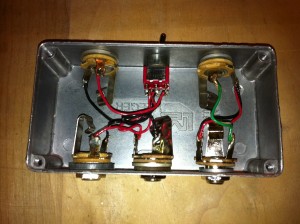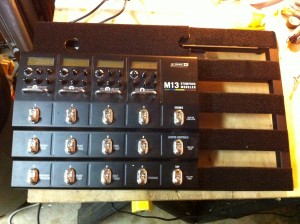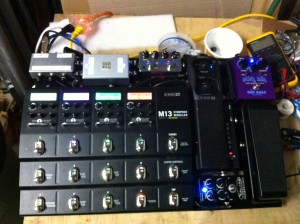Guitar Pedalboard : Rebuilding And Rewiring
- PedalTrain PT-3. PedalTrain makes very sturdy welded aluminum pedalboards, available in several sizes. This one is 16 x 24 and fits perfectly into the hard case that came with my PT-2. The extra real estate on this board allowed me to put several favorite pedals back into play.
- Custom switch interface. This box has two primary functions (1) it switches between the wired and wireless guitar inputs (2) it moves the wired guitar input and signal output to the back left corner of the pedalboard for ease of patching onstage. This is a gizmo I built from a pedal-sized aluminum box and some quality time with the drill press and soldering iron.
- Line6 G50 Wireless System. I’ve used several wireless systems over the years. The Line6 Relay wireless systems are the best I’ve ever tried.
- Road Rage dual channel buffer. Road Rage sells prebuilt and kit versions of several useful pedals including custom loop switchers. Their signal buffers are very clean and allow me to run a long cable back to my amp with minimal signal loss.
- Keeley 4-knob Compressor. Anyone looking into boutique effect pedals knows about Keeley. They make amazing equipment. This compressor is astonishingly transparent. I also have a fantastic Keeley-modded wah pedal, but it doesn’t fit on this board.
- Way Huge Pork Loin. Of the countless “tube screamer” clones out there, this one is my current favorite. Being able to dial in the original clean signal is very nice.
- ZVex Box of Rock. This box advertises itself as a “Marshall Stack in a box”. It’s certainly lighter than a Marshall Stack.
- Line6 M13. This is the backbone of my effects matrix onstage. The M13 is a great-sounding all-around pedalboard. I have a number of wish list modifications for Line6 (USB, editor GUI, size concerns) but at the moment it’s the best overall multi-effect unit I have found.
- Mission Control EP1-L6 Controller. Mission Control makes great controllers. This one looks and feels like a Crybaby wah, but it’s actually a continuous controller for the Line6 M13. I can use it as a wah, or to sweep between points on the effects processors.
- Morley Mini Volume Pedal. This is an optical volume pedal and happens to be the smallest good-quality volume pedal that I can find.
- Power Strip
- 1 Spot power supply.
- George L cables and connectors
- Switchcraft right-angle plugs
Signal Chain
Input (wired / wireless) -> buffer -> Keeley compressor -> Pork Loin -> Box Of Rock -> M13 -> Morley Volume Pedal -> buffer -> amp
The (recent) history of my pedalboard
This is the third (!) complete teardown and reconfiguration of my pedalboard in the past year, but I think this one is going to stick around for while. My “big” board was based on the PedalTrain PT-Pro. At 16 x 32 inches it had more than enough room for all my pedals but was too big and too heavy – especially in its flight case. The “small” board was based on the PedalTrain PT-2 which 16 x 12.5 inches. I’ve been using this one for most of the past year. It has just enough room for the Line6 M13, the Mission Control pedal, Morley Mini Volume pedal, and the Line6 G50 receiver. I’ve been wanting to add a few boutique pedals to layout but didn’t have the room on the previous board. The PT-3 accommodates these extra pedals and still fits inside the flight case that came with my PT-2. This leaves me with a PT-2 and the soft carry bag that came with the PT-3, which should be easy to sell.




Fuck yes. I was so excited reading this just now! It made me want to give up everything about playing keyboards and piano and switch to guitar—- noise guitar specifically.